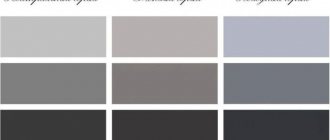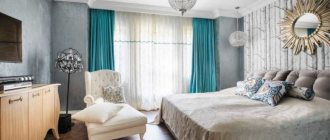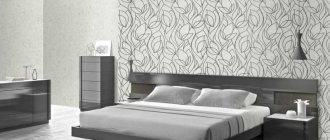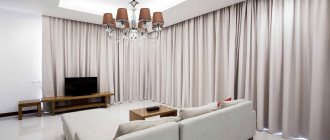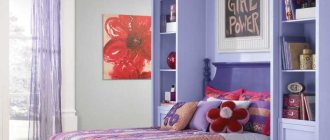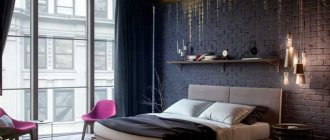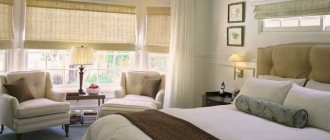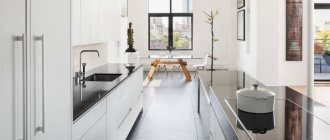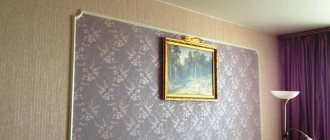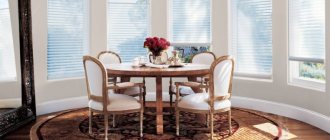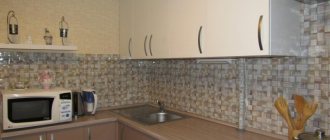New ideas from designers
Wallpaper is intended for decorative decoration of room surfaces and hiding cracks (other defects) in walls and ceilings. The material is produced in rolls up to 1.06 meters wide. Some models contain special fibers that are designed to reduce noise levels. In private households, such wallpaper is rarely used. This option is widely used in workshops where good sound insulation is needed.
Today, a huge number of types of finishing materials are known. Each of them has its own advantages and disadvantages.
- Paper wallpaper is the most common option of all. The advantages of wallpaper include a low price, a huge range of colors and textures, and easy installation of the material. The disadvantage of paper wallpaper is the impossibility of pasting rooms with high humidity.
Paper wallpaper reliably hides uneven surfaces and also retains heat in the room. This is due to the fact that the material consists of several layers of thick paper.
The modern design of paper-based wallpaper looks very impressive. The material for finishing walls and ceilings consists of a layer of paper onto which a pattern is applied. Among wallpapers of this type, embossed wallpapers have recently become very popular. Their special feature is a three-dimensional pattern, which gives the wall an effect of scale and hides the cracks and joints of the surface.
- Vinyl wallpaper is a wall decoration product made from paper or non-woven fabric. A distinctive feature of vinyl wallpaper is the presence of a top layer coated with polyvinyl chloride. This technology makes it possible to create a product that has increased strength and the ability to withstand external contaminants.
Vinyl wallpaper consists of two layers:
- the bottom one is made of paper. It is glued to the wall or ceiling.
- The top layer of wallpaper is covered with a pattern or embossing.
Polyvinyl chloride wallpaper gives the interior a beautiful look and hides flaws in the plaster.
- Non-woven wallpaper is another common option for interior decoration. They consist of a cellulose base and a pattern that is created using embossing. Such wallpapers are considered environmentally friendly and durable. A huge advantage is good adhesion to the surface. Such wallpaper does not need to be coated with glue. It is enough to apply it to the wall, since non-woven fabric does not shrink. Non-woven wallpaper is unpretentious in maintenance. If they become dirty, they can be cleaned with a damp cloth.
- Paintable wallpaper consists of a fabric base and additional elements (soda). They are applied to the surface and then painted with latex paint. The advantages include environmental friendliness and non-flammability. However, among wallpapers for painting there is a very poor choice of patterns and colors. Therefore, this option is more often used in office premises.
- Liquid wallpaper has recently appeared on the finishing materials market. Nevertheless, they managed to gain enormous popularity among other types of finishing. What is the secret of this phenomenon? Liquid wallpaper consists of a cellulose base. Therefore, they are completely safe from an environmental point of view. Wallpaper is sold in packages and is a powdery mass. They are diluted in water and kneaded until a homogeneous mass is formed. You can also add natural dyes (gilding) to the mixture. They will give the interior a richer look.
The adhesive for attaching wallpaper should be selected according to the type of material being pasted. Construction stores offer a large assortment from various manufacturers. You can choose glue to suit every taste and budget. The choice remains with the end consumer: the most important thing is to purchase a product with good technical characteristics.
When choosing a glue, you need to remember that it is based on modified starch. Depending on the manufacturer, there may be additional chemicals. Therefore, to avoid allergic reactions when carrying out repairs, you need to carefully read the composition of the product.
Gift packaging
At the last minute you were invited to a special event? Don't have a nice package of the right size at home? Take the remaining wallpaper, place the gift, wrap it and secure it with tape. Wrap a satin ribbon on top and tie a beautiful bow.
Wallpaper gift wrapping
For a child's birthday, you can give the child a gift box in the form of candy. We wrap a gift, such as a towel. We squeeze the ends a little with our hands and tie them.
Original gift packaging in the form of candy
The rectangular shape is the easiest to fold, but you can also make other interesting packaging shapes, such as a handbag.
How to choose high-quality wallpaper?
Choosing a high-quality material for interior decoration is not an easy task. Before going to a hardware store, it is recommended to study photos of wallpaper design on the Internet or in specialized literature. When choosing wallpaper, you should pay close attention to a number of factors.
- Class of the room being finished. Wallpaper should be suitable for the use of the room.
- For the hallway, choose a design with gray wallpaper.
- If the wall has flaws in the plaster and cracks, it is best to choose liquid or non-woven wallpaper. Paper versions may not stick well to the surface and may not cover all the unevenness of the surface being finished.
Before purchasing finishing material, you need to pay attention to the classification of wallpaper. Manufacturers apply special markings to the packaging of their products. It shows the maximum exposure to sunlight that a particular product model can withstand. Some types of wallpaper, for example, turn yellow and lose their color under certain lighting conditions in the room.
Note!
- Glass wallpaper - what is it? Pros and cons, types, features, characteristics, photos of design and combinations in the interior
Plain wallpaper - 150 photos of modern design. Rules for choosing and combining wallpaper in the interior: kitchen, bedroom, living room, hallway
Wallpaper framed on the wall in the interior: photos of original design and beautiful decor
- When choosing wallpaper for pasting, the color scheme should be combined with the overall interior of the room. When purchasing, you need to focus on your own artistic taste and preferences. Although there are several standard rules for choosing colors.
- In small rooms it is preferable to use white wallpaper design. This will visually expand the boundaries of the room and create a cozy atmosphere.
- It is better to stick calm, light colors into the living room and bedroom. This is necessary to obtain a visual effect of relaxation and comfort.
The best option would be to buy paper, non-woven or liquid wallpaper. To glue non-woven models you will need special glue. Liquid wallpaper is applied using a spatula.
- The price range plays an important role when purchasing finishing materials. It is better to choose wallpaper in the middle price segment, although if you have the financial opportunity, it is better to choose the premium segment. This is due to the fact that the expensive model is made from high-quality, environmentally friendly materials. Also, the high cost of the finishing material in most cases guarantees the durability of the product and ease of installation.
The most affordable materials are paper and liquid wallpaper. Although everything also depends on the volume of the room being finished. The most correct decision in this case: carefully study the finishing area and make an accurate decision when purchasing wallpaper.
When purchasing finishing materials, in addition to color, you need to pay attention to this.
- The product must be hermetically packaged and have special markings on the container.
- All purchased rolls must belong to the same batch.
- It is better to buy one roll more. This will allow you not to be distracted by going to the store if, in an unexpected situation, there is not enough material.
Liquid wallpaper in the interior
Liquid wallpaper is applied with a spatula onto paint or plaster. This method of gluing allows you to hide cracks and other surface irregularities.
Wallpaper has durability and dirt-repellent properties. It is not recommended to stick liquid wallpaper in rooms with high humidity.
Combination options
You can combine wallpaper in the interior in different ways, but among all the methods you can identify the most popular design techniques:
- Horizontal division - a plain or striped surface at the bottom, and a large or small pattern at the top;
- Alternating vertical stripes and a large pattern - on a striped background there are wide areas with a print.
- They are usually located on opposite walls and can be asymmetrical;
- Highlighting an area with texture or color;
- A combination of wallpaper with other finishing materials.
Advice! It is desirable that the combined wallpaper belong to the same series or at least match the color and thickness of the material.
Wallpaper design for the kitchen
You can choose a combined wallpaper design for your kitchen wallpaper. At the same time, bright and light colors alternate with darker variations in the area of the gas stove and sink.
This is necessary to visually hide dirt and splashes. Using washable wallpaper is also a good option.
We make blinds for windows
Wallpaper blinds look interesting and unusual.
Paper blinds are a great idea for the kitchen and veranda. To create this product you will need thick wallpaper. Non-woven samples in pale tones that reflect light are ideal. The operating algorithm is as follows:
- Cut a sheet that matches the width of the glass, but is 25% longer than its length.
- Assemble the wallpaper with an accordion. The size of the folds can fluctuate around 2.5-5 cm.
- Make a small hole in the middle of the folded fabric. The cord should be inserted here and then the blinds should be straightened.
- The curtains are attached to the window using double-sided tape.
- The 5 folds at the bottom must be glued in the middle and secured with tape. The result should be a “peacock tail”.
- Equip the cord with a lock.
- Such blinds look unique, and this with minimal time and financial costs.
New Wallpaper Designs
You can decorate a room with excellent wallpaper on your own. The main thing is to study the wallpaper trend in 2020 design and implement it in your own apartment.
- Environmental orientation of the product.
- Well-chosen wallpaper tone.
- Matte wallpaper and gradient effect (many shades).
- 3D wallpaper and animal designs.
- Using lighting in bedroom wallpaper design.
Bed head decor
You can use the remaining wallpaper to make a headboard if you don’t have one. This usually happens if the bedroom is small, since beds with massive headboards are more common in spacious rooms. You can simply cover part of the wall behind the bed with wallpaper of a different color, or give the headboard some shape. The choice depends on your taste preferences. Against the background of a plain wall, wallpaper with a pattern will look chic, especially if you choose bedding with similar patterns.
Decorative headboard made from wallpaper
Door decor with wallpaper
